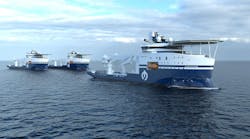Editor's note: This Data section first appeared in the November-December 2022 issue of Offshore magazine. Click here to view the full issue.
FPSOs lead charge as deepwater dominates liquids supply from startups
The offshore sector is set to overtake onshore this decade in terms of contribution to global liquids production from new project startups, with FPSO schemes leading the charge. Global liquids demand is forecast to rise from about 92 MMbbl/d in 2020 to a peak of about 107 MMbbl/d by 2025. Additionally, liquids supply is on course to grow by more than 5 MMbbl/d this year over 2021—99 MMbbl/d as against 94 MMbbl/d—with the onshore conventional and tight oil sectors the primary drivers. In terms of conventional liquids production from project startups, the onshore sector was dominant between 2010 and 2020. However, offshore is set to rule over the current decade in terms of liquids supply from fields that have started up or are scheduled to come online by 2030.—Rystad EnergySignificant portion of older rig units remain in fleet
Excluding rigs under construction and units that are non-competitive, about 24% of the global offshore drilling rig fleet is older than 30 years. The spate of recycling undertaken during the recent downturn reduced the number of older units in the fleet, but a significant portion remains and many of these still work. As these units continue to age, those that have not yet undergone lengthy renewals and life-extension activities will need to be pulled from availability. With supply chain issues contributing to lengthening yard visits, these jobs will take longer than in the past, thus tightening availability even further.—Esgian
Offshore CCS projects breathe new life into GoM
There are 22 carbon capture storage (CCS) projects in the US, which accounts for 19% of global activity. Wood Mackenzie surmises that the Gulf of Mexico (GoM) is emerging as a new hub of activity, with six projects in the development or planning phase. Texas and Louisiana combined for close to 500 MMtCO2e of emissions in 2021, 20% of the US total emissions. With the US targeting greenhouse-gas emission reductions of 50% from 2005 levels by 2030, these new CCS projects could play an important role. Initial projects won’t target upstream emissions. Instead, projects will target emissions from the Gulf Coast’s large industrial sector. Emissions from these operations would be piped to former rigs retrofitted for sequestering. CO2 can then be safely injected into saline aquifers or depleted oil and gas reservoirs.—Wood Mackenzie








